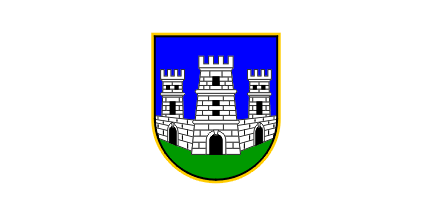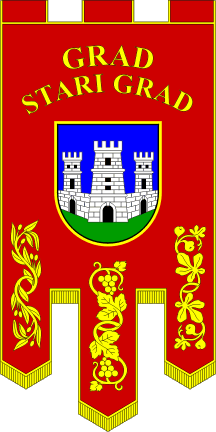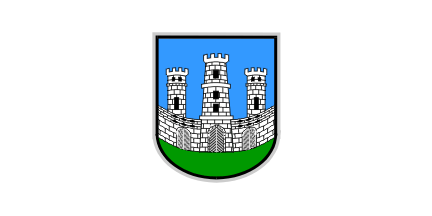
image by Željko Heimer, 4 August 2004

Last modified: 2010-01-22 by dov gutterman
Keywords: split | dalmatia | splitsko-dalmatinska | stari grad |
Links: FOTW homepage |
search |
disclaimer and copyright |
write us |
mirrors

image by Željko Heimer, 4 August 2004
See also:
Other Sites:
The city of Stari Grad is on the Hvar island, about 40 km
south of Split in the Split-Dalmatia
County. It has under 3,000 inhabtants, less then 2,000 in the
city itself. It should not be confuzed with Starigrad (Paklenica)
in the Zadar county and an other Starigrad near Koprivnica, and
therefore it is often referd to as "Stari Grad na
Hvaru". Untill 1997 it had the community status.
The coat of arms pictures the city within walls and with three
towers in blue shield on a green hill. This is a historical coat
of arms, but until now I have not found anything firm about it
previous history.
The flag is white with the yellow bordered coat of arms in the
middle.
There is also the ceremonial flag, red three tailed gonfalon with
the coat of arms in the middle, the name inscribed above in two
arches and three different floral ornaments in three tails at the
bottom - an olive, a vine and a figue.
As we have seen with some other cities using the white flag, the
ceremonial flag do not follow the same colour for it base.
Possibly due that the white ceremonial flag would be sustainable
to stain to much? Or simply the golden ornaments would not stand
out as good on the white...
Sources: Stari Grad <www.stari-grad-faros.hr>
(07.10.2003). Information from Tomislav Šipek following HTV,
10.2003.
Željko Heimer, 4 August 2004
The symbols were designed by the Heraldic
Art d.o.o. from Rijeka.
Željko Heimer, 3 November 2007
On the official site of the city there are the official
gazettes all the way back since 1993, with several decisions
interersting to us:
- Odluka
o grbu opcine Stari Grad, 19.05.1993. Službeni glasnik
Opcine Hvar, br. 2/1993, 16.08.1993. str. 90-91
The coat of arms detemined with this decision is of oval shape,
azure on a base vert the city walls without embattlements with
three open doors, above the central an oval embattled tower with
3 (1-1-1) windows and a parapet and to its left and right each a
shorter oval embattled tower with three (2-1) windows. The shield
is set in an oval barque cartouche. It is also noted that such
coat of arms is stone-carved, set in the bulding of the
community.
The flag is not mentioned.
- Odluka
o grbu i zastavi Grada Starog Grada, 30.10.1997. Službeni
glasnik Grada Starog Grada, br. 4/1997, 10.11.1997. str. 42-44
This decision supersedes the 1993 decision (probably after the
unsucessful approval of the 1993 coat of arms with the central
authorities). However, the text of the decision still describes
the shield to be oval. The flag is described with with the coat
of arms in the middle bordered with a silver outline. The
ceremonial flag is described only as being made of silver and
with golden fringe, presumably of the same design as the official
flag.
- Odluka
o grbu i zastavi Grada Starog Grada, 14.03.2001, Službeni
glasnik Grada Starog Grada, br. 1/2001, 22.03.2001. str. 13-14
This supersedes the 1997 decision. The shield is now
semi-circular, and the description is less verbose - azure, on a
base vert silver city walls with three 3-storied embattled
towers, the middle one being tallest, each with open doors. The
flag is again white, with this coat of arms in the middle, but
bordered golden/yellow. The ceremonial flag is only mentioned to
be in existance.
The new city
statutes of 11 October 2001 includes now these descriptions
- In the official gazette nr. 7/2002 a decision on amendments of
the 2001 decision on the coat of arms and the flag was issued,
unfortunately, this iisue of the official gazette is not
available on the web site, however, already nr. 8 of the gazette
includes a decision on invalidating of the nr. 7/2002 decision,
so the original 2001 decision stands unchanged. I believe that
these decision were about the penal determinations. Odluka
o stavljanju izvan snage Odluke o izmjenama Odluke o grbu i
zastavi Grada Starog Grada, 12.12.2002, Službeni glasnik
Grada Starog Grada, br. 8/2002, 20.12.2002. str. 121.
- Based on these decision, teh city issued a grant to the Elderly
home in Stari Grad to use the coat of arms in its seals (gazette
nr. 11/2003).
- The 2002 decision was amended again in 2004, again regarding
the penal parts. Odluka
o izmjenama Odluke o grbu i zastavi Grada Starog grada,
04.10.2004, Službeni glasnik Grada Starog Grada, br. 8/2004,
11.10.2004. str. 153.
Looking into two older sources, there are a few more things to
say about Stari Grad.
In Lazsowski's "Grbovi Jugoslavije", 1936, the coat of
arms virtually the same as the current design is shown. The
blazon he provides is almost word for word equal to the 1993
decision wording (they must have copied it from here). He does
not say much more on the origins of the coat of arms, only
mentioning that there are historical seals and coats of arms
preserved that seved as his sources.
Ströhl in his "Städte-Wappen von Ö-U"m 1904 has
more. Under Citt`avecchia (Starigrad) he gives as its ancient
coat of arms: gules, on a base vert embattled city walls with
three towers. Basically, the same as used today - with the red
instead of blue (you might have already noticed that red shield
backgrounds were tended to be replaced by blue during 19th
century in numerous examples in Croatian municipal heraldry -
there seems to be no real explanation for that - my theory is
that the old coats of arms were drawn from seals, which were
basically printed in red wax, while in modern times, they were
ever more seen as "pictures" of these cities, and the
background is then seen as the sky... However, I have no
confirmation for this theory).
However, Ströhl notes that in 1879 a new coat of arms was
grnated, of a complex design: quartered, 1) a stone pine
(umbrella pine, Pinus pinea), a vine in an wheat field with a
goat, symbolic for the fertility of the region; 2) an antique
sail ship, symbolic for the Greek colonisation; 3) a large stone
masoned wall on the bank of a bay, for the old Pharos, with an
olive tree, myrtle and rosemary and 4) symbolic for hope, a
raising sun and, as Ströhl say "etc." actually showing
a lion standing on a clif and a swallow flying above. The book
does not include the drawing of the ornaments around the shield,
but describes them in the text: two green snakes
("umzogen" - surround (enclose, encircle) ) carying the
motto "LABOREMVS" (i.e. Let's work). As mentioned a few
days ago, Ströhl also mentions the city banner, probably a
gonfalon - being blue with that coat of arms in the middle.
Željko Heimer, 29 August 2009

image by Željko Heimer, 4 August 2004
st-sg.gif)
image by Željko Heimer, 4 August 2004
Flag

image by Željko Heimer, 29 August 2009
Coat of Arms
st-sg97.gif)
image by Željko Heimer, 29 August 2009